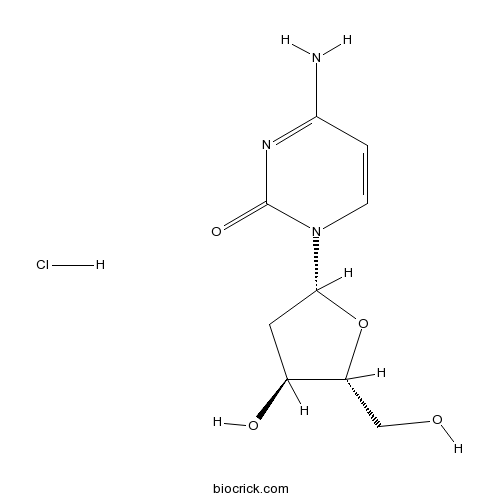2'-Deoxycytidine hydrochlorideCAS# 3992-42-5 |

- (24R)-MC 976
Catalog No.:BCC1289
CAS No.:112828-09-8
- (24S)-MC 976
Catalog No.:BCC1291
CAS No.:112849-14-6
- 1alpha, 25-Dihydroxy VD2-D6
Catalog No.:BCC1299
CAS No.:216244-04-1
- 1alpha, 24, 25-Trihydroxy VD2
Catalog No.:BCC1298
CAS No.:457048-34-9
Quality Control & MSDS
3D structure
Package In Stock
Number of papers citing our products

| Cas No. | 3992-42-5 | SDF | Download SDF |
| PubChem ID | 107488 | Appearance | Powder |
| Formula | C9H14ClN3O4 | M.Wt | 263.68 |
| Type of Compound | N/A | Storage | Desiccate at -20°C |
| Synonyms | 2'-Deoxycytidine monohydrochloride; Deoxycytidine hydrochloride; NSC 83251 | ||
| Solubility | H2O : ≥ 41 mg/mL (155.49 mM) *"≥" means soluble, but saturation unknown. | ||
| Chemical Name | 4-amino-1-[(2R,4S,5R)-4-hydroxy-5-(hydroxymethyl)oxolan-2-yl]pyrimidin-2-one;hydrochloride | ||
| SMILES | C1C(C(OC1N2C=CC(=NC2=O)N)CO)O.Cl | ||
| Standard InChIKey | LTKCXZGFJFAPLY-OERIEOFYSA-N | ||
| Standard InChI | InChI=1S/C9H13N3O4.ClH/c10-7-1-2-12(9(15)11-7)8-3-5(14)6(4-13)16-8;/h1-2,5-6,8,13-14H,3-4H2,(H2,10,11,15);1H/t5-,6+,8+;/m0./s1 | ||
| General tips | For obtaining a higher solubility , please warm the tube at 37 ℃ and shake it in the ultrasonic bath for a while.Stock solution can be stored below -20℃ for several months. We recommend that you prepare and use the solution on the same day. However, if the test schedule requires, the stock solutions can be prepared in advance, and the stock solution must be sealed and stored below -20℃. In general, the stock solution can be kept for several months. Before use, we recommend that you leave the vial at room temperature for at least an hour before opening it. |
||
| About Packaging | 1. The packaging of the product may be reversed during transportation, cause the high purity compounds to adhere to the neck or cap of the vial.Take the vail out of its packaging and shake gently until the compounds fall to the bottom of the vial. 2. For liquid products, please centrifuge at 500xg to gather the liquid to the bottom of the vial. 3. Try to avoid loss or contamination during the experiment. |
||
| Shipping Condition | Packaging according to customer requirements(5mg, 10mg, 20mg and more). Ship via FedEx, DHL, UPS, EMS or other couriers with RT, or blue ice upon request. | ||

2'-Deoxycytidine hydrochloride Dilution Calculator

2'-Deoxycytidine hydrochloride Molarity Calculator
| 1 mg | 5 mg | 10 mg | 20 mg | 25 mg | |
| 1 mM | 3.7925 mL | 18.9624 mL | 37.9248 mL | 75.8495 mL | 94.8119 mL |
| 5 mM | 0.7585 mL | 3.7925 mL | 7.585 mL | 15.1699 mL | 18.9624 mL |
| 10 mM | 0.3792 mL | 1.8962 mL | 3.7925 mL | 7.585 mL | 9.4812 mL |
| 50 mM | 0.0758 mL | 0.3792 mL | 0.7585 mL | 1.517 mL | 1.8962 mL |
| 100 mM | 0.0379 mL | 0.1896 mL | 0.3792 mL | 0.7585 mL | 0.9481 mL |
| * Note: If you are in the process of experiment, it's necessary to make the dilution ratios of the samples. The dilution data above is only for reference. Normally, it's can get a better solubility within lower of Concentrations. | |||||

Calcutta University

University of Minnesota

University of Maryland School of Medicine

University of Illinois at Chicago

The Ohio State University

University of Zurich

Harvard University

Colorado State University

Auburn University

Yale University

Worcester Polytechnic Institute

Washington State University

Stanford University

University of Leipzig

Universidade da Beira Interior

The Institute of Cancer Research

Heidelberg University

University of Amsterdam

University of Auckland

TsingHua University

The University of Michigan

Miami University

DRURY University

Jilin University

Fudan University

Wuhan University

Sun Yat-sen University

Universite de Paris

Deemed University

Auckland University

The University of Tokyo

Korea University
Deoxyguanosine Hcl(2'-Deoxyguanosine Hcl) is composed of the purine nucleoside guanine linked by its N9 nitrogen to the C1 carbon of deoxyribose.
References:
[1]. Deoxyguanosine, From Wikipedia
- 29-Hydroxyfriedelan-3-one
Catalog No.:BCN5453
CAS No.:39903-21-4
- H-D-Phe(4-OMe)-OH
Catalog No.:BCC2633
CAS No.:39878-65-4
- PHA-680632
Catalog No.:BCC2178
CAS No.:398493-79-3
- JNJ 5207852 dihydrochloride
Catalog No.:BCC6101
CAS No.:398473-34-2
- 19-Hydroxybufalin
Catalog No.:BCN8237
CAS No.:39844-86-5
- Methyllinderone
Catalog No.:BCN5452
CAS No.:3984-73-4
- Amikacin disulfate
Catalog No.:BCC4622
CAS No.:39831-55-5
- H-Ala-OiPr.HCl
Catalog No.:BCC3193
CAS No.:39825-33-7
- Epitulipinolide diepoxide
Catalog No.:BCN5451
CAS No.:39815-40-2
- Taibaihenryiins A
Catalog No.:BCN3281
CAS No.:398129-59-4
- Penciclovir
Catalog No.:BCC4695
CAS No.:39809-25-1
- Azatadine dimaleate
Catalog No.:BCC4536
CAS No.:3978-86-7
- Norglaucine hydrochloride
Catalog No.:BCN6568
CAS No.:39945-41-0
- LY 78335
Catalog No.:BCC6109
CAS No.:39959-66-5
- Victoxinine
Catalog No.:BCN6745
CAS No.:39965-06-5
- HOAt
Catalog No.:BCC2815
CAS No.:39968-33-7
- Delta-9-Tetrahydrocannabivarinic acid
Catalog No.:BCN7967
CAS No.:39986-26-0
- p-Hydroxy-5,6-dehydrokawain
Catalog No.:BCN3597
CAS No.:39986-86-2
- Laricitrin 3-O-glucoside
Catalog No.:BCN8149
CAS No.:39986-90-8
- H-Thr-OMe.HCl
Catalog No.:BCC3104
CAS No.:39994-75-7
- 24, 25-Dihydroxy VD3
Catalog No.:BCC1303
CAS No.:40013-87-4
- Syringetin-3-O-glucoside
Catalog No.:BCN2610
CAS No.:40039-49-4
- SU 3327
Catalog No.:BCC7725
CAS No.:40045-50-9
- N6-Benzoyladenine
Catalog No.:BCC9075
CAS No.:4005-49-6
Free radical formation in X-irradiated crystals of 2'-deoxycytidine hydrochloride. Electron magnetic resonance studies at 10 K.[Pubmed:10825758]
Radiat Res. 2000 Jun;153(6):823-34.
Single crystals of deoxycytidine hydrochloride (CdR.HCl) have been X-irradiated at 10 K with doses up to about 150 kGy and studied using 24 GHz (K-band) EPR, ENDOR and FSE spectroscopy. In this system, the cytosine base is protonated at the N3 position. Nine different radicals were characterized and identified. Three of these are ascribed to three versions of the one-electron reduced species, probably differing in their protonation state. Radicals formed by net hydrogen addition to the cytosine C5 and C6 positions were observed at 10 K. The hydrogen-abstraction radical at the deoxyribose C1' position most probably results from initial oxidation of the base. The remaining radical species are all localized to the sugar moiety, representing products formed by net hydrogen abstraction from three of the five available carbons of the deoxyribose sugar. The lack of base-centered oxidation products as well as the structures of the one-electron reduced species is rationalized by considering the specific proton donor-acceptor properties of this crystalline lattice in comparison with similar systems.


